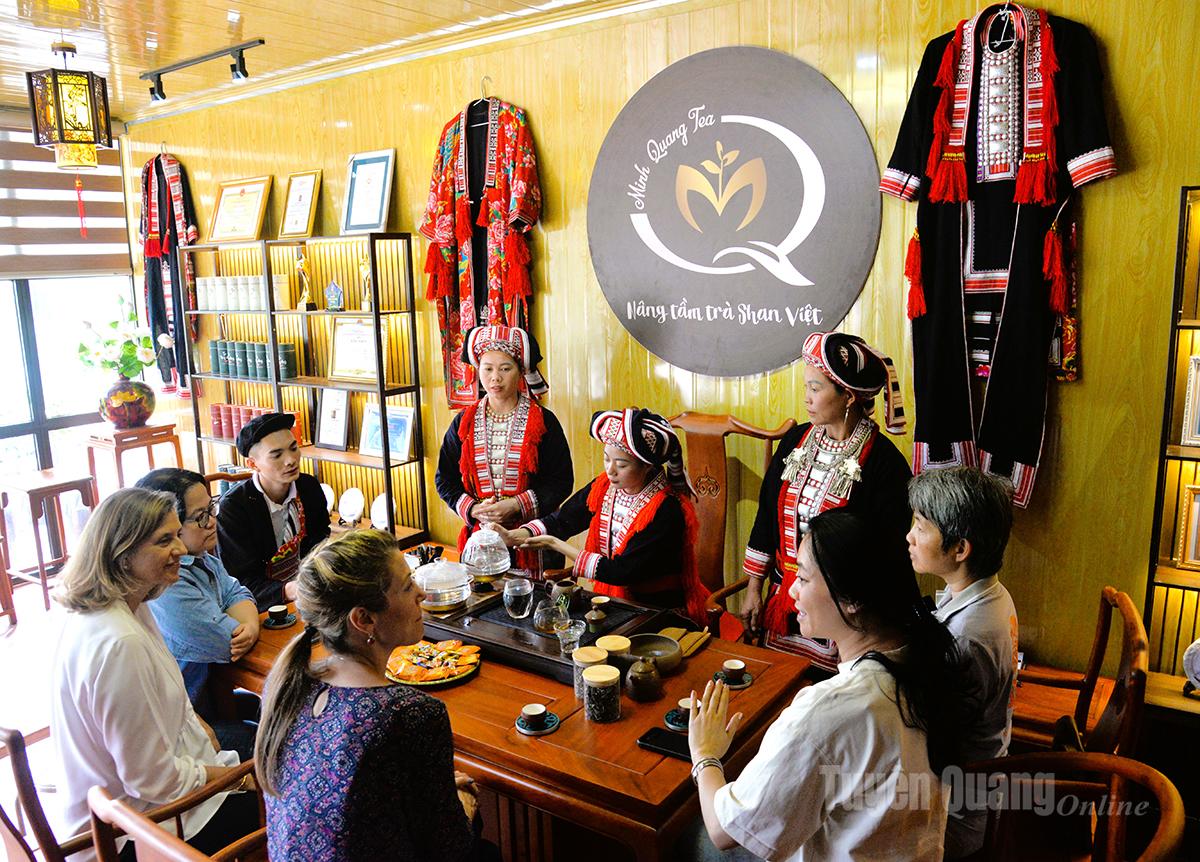Creating momentum to boost the cooperative economy
In recent years, the cooperative economy in Tuyen Quang province has made significant strides in quantity, quality and operational efficiency. Cooperatives not only contribute to restructuring the agricultural sector but also create jobs, increase incomes and improve local people’s living standards.
 |
| Minh Quang Tea Cooperative in Minh Son hamlet, Thong Nguyen commune introduces its tea products to domestic and international consumers. |
After nearly six years in operation, Minh Quang Tea Cooperative in Minh Son hamlet, Thong Nguyen commune has successfully developed a closed-loop Shan Tuyet tea production value chain. From raw material area to processing and consumption, the cooperative guides 129 households in six hamlets to grow organic tea without chemical pesticides, meeting HACCP food safety standards.
According to Mr. Phung Sun Choi, the cooperative processes about 120 tonnes of fresh tea annually into a variety of products, including white-tea and black tea. Several products have been certified as 4-star OCOP items at the provincial level, with prices ranging from VND2 million to VND4 million per kilogram. The cooperative is piloting new tea blends featuring medicinal herbs, fruits, and flowers, to penetrate demanding markets such as the EU and the Middle East.
However, Choi noted challenges including limited capital, weak marketing and communication skills, and underdeveloped packaging and branding. Some raw material areas are not yet sustainable and remain vulnerable to market price fluctuations.
Also leveraging local agricultural products, Hong Phat Organic Agricultural Cooperative in Kim Binh Commune has built a successful value chain producing black bean tea bags, a 4-star OCOP product. The cooperative works with 120 households across Kim Binh, Minh Quang, and Tri Phu communes, cultivating 75 hectares and producing three crops annually.
Notably, this raw material area once had a high poverty rate. The black bean cultivation model has transformed lives, particularly among Mong ethnic households. For instance, Ly Van Sai’s family in Khuon Lan Hamlet, Tri Phu Commune, earns over VND 100 million annually from two hectares of black beans—much higher than previous maize or rice cultivation.
Representative Pham Thi Hong said: “We regularly test products and package them to meet the standards of each market. In 2024, the cooperative earned over VND4 billion in revenue, with exports accounting for 20% and profits reaching VND400 million. However, to expand markets and raw material areas, we need more support in digital transformation, international trade skills, and market exploration.”
The province currently has 1,546 cooperatives with 34,853 members and a total operating capital exceeding VND 1.6 trillion. Most are engaged in agriculture and forestry, with many new-style cooperatives successfully linking producers, organizing large-scale production, applying high technology, and marketing OCOP-certified products.
Annually, cooperatives receive training in management, market connection, and support for applying digital technology and e-commerce. However, most remain small-scale, financially weak, and struggle to access preferential loans due to a lack of collateral and tailored credit mechanisms. Limited production infrastructure, land, and skilled young workers also hinder expansion.
According to Cao Hung Dung, Chairman of the Tuyen Quang Cooperative Alliance: “In the context of integration, demand for clean, traceable, high-standard agricultural products is increasing. This presents opportunities for the cooperative economy. However, for cooperatives to become pillars of the rural economy, state support is needed to improve policies on land, loans, infrastructure, and human resources training.”
With grassroots flexibility and creativity, combined with support from authorities at all levels, the cooperative economy can develop sustainably, become a driving force for new rural development, boost agricultural restructuring, and enhance the livelihoods of rural and mountainous communities.
Moc Lan





READER COMMENTS